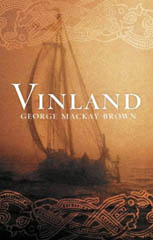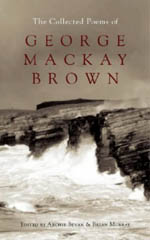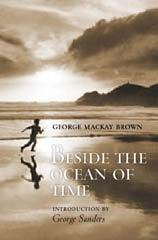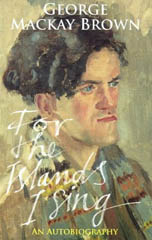Interview with Maggie Fergusson
 How did you come to meet George Mackay Brown?
How did you come to meet George Mackay Brown?
In the autumn of 1991 I started working for the Royal Society of Literature, which had very large, rather eccentric offices in Hyde Park Gardens in London. The Society had an enormous library that included all the books of all its fellows, past and present. Until then, I’m ashamed to say I’d never heard of him. I started reading his work and was absolutely bowled over by it, especially the imagery in his poetry: ‘Lovers under the buttered bannock of the moon’
… ‘Sunset drove a butcher blade through the day’s throat’. Beautiful images, so natural and so apt they almost read as if he hadn’t invented them, he’d discovered them, they must have always been there.
 He lived in Orkney and practically never came south. But in 1992, he had a new novel, Vinland, coming out and I asked the Times whether I might go and interview him. I had never been to Orkney before. As soon as I arrived there I had the most extraordinary feeling that the place was somehow familiar to me. It’s almost like a sort of homecoming every time I go back there.
He lived in Orkney and practically never came south. But in 1992, he had a new novel, Vinland, coming out and I asked the Times whether I might go and interview him. I had never been to Orkney before. As soon as I arrived there I had the most extraordinary feeling that the place was somehow familiar to me. It’s almost like a sort of homecoming every time I go back there.
On my first evening in Stromness, I had fish and chips on the pier by myself with one of George’s books and thought, ‘I love this place.’ I couldn’t wait to meet him. The following day, I went and knocked on his door. He was very welcoming but it was probably the worst interview ever. I had prepared lots and lots of questions and he came back with monosyllabic answers. He wasn’t unfriendly in any way but he wouldn’t be drawn. I remember, for example, asking him about his Catholicism. He said, ‘Well, you know, I wrote an article about that once in the Tablet and I’m sure you could get a back copy and I’ve nothing to add to what I’ve said.’ After ten minutes I had to admit defeat. He sat back in his rocking chair by the fire, stretched, looked into the middle distance, his head slightly on one side and he just hummed. He seemed perfectly happy. I sat on the sofa trying to seem perfectly happy but I was thinking, ‘What on Earth am I going to say to the editor of the Times?’ – who had set me on this rather expensive journey to Orkney. I had absolutely nothing to write. So I went away pretty anxious.
What did you do after you left?
 I had been so happy the evening before, but that second evening it all felt like a disaster. Fortunately, I had four days in Orkney. The day after the interview I bumped into George and he invited me to come over at teatime. There were four or five other people there. In familiar company he opened up and I saw a totally different man. He talked about his sister Ruby and how she used to recite poems, tell him stories and sing for him as a child. He was very, very witty. That was something very difficult to get across in the book. He was a brilliant mimic and a very talented raconteur, though never at anyone’s expense. And he was so hospitable.
I had been so happy the evening before, but that second evening it all felt like a disaster. Fortunately, I had four days in Orkney. The day after the interview I bumped into George and he invited me to come over at teatime. There were four or five other people there. In familiar company he opened up and I saw a totally different man. He talked about his sister Ruby and how she used to recite poems, tell him stories and sing for him as a child. He was very, very witty. That was something very difficult to get across in the book. He was a brilliant mimic and a very talented raconteur, though never at anyone’s expense. And he was so hospitable.
Before we left, he said he wanted to show me something he thought I might be interested in. Somebody had sent him a photocopy of a letter that’s in the National Library – the letter Mary Queen of Scots wrote to her cousin, the King of France, the day before she died. George said he wanted me to look at it carefully because he was so impressed by how firm and steady her script was the night before she died. I was rather touched he’d taken me aside to show me this particular thing. I saw him two more times over the next couple of days before I had to go home. I felt I’d made a friend.
When I got back to London I was so completely mesmerised by Orkney, George and his writing that I could hardly bear to be back. I remember sitting a whole morning in my flat in Battersea. I couldn’t bear to open the curtains. I wanted to somehow make sure that these memories of George and Orkney stayed in my mind. I wrote to thank him and he wrote back to me, mostly about the weather, what he’d had for lunch. In amongst that sort of thing there was ‘I hope you’ll come back often, Maggie
… I feel you belong here in Orkney.’ I got back to Orkney whenever I could, on journalistic commissions.
That would allow you to absorb the feeling of the place, the landscape…
I didn’t know at that stage that I was going to be writing the biography, so I wasn’t thinking, ‘I must try and get under the skin of this place.’ I just loved being there and writing about it.
What do you think of what George Mackay Brown said about writers being like any other worker, whether a farmer or a woodworker…
Or a plumber
… not that writers aren’t important, but that plumbers and labourers are. A bit like Gerard Manley Hopkins seeing in everyone ‘the immortal diamond’.
What I took from it was a suggestion of a spiritual outlook, a notion of humility.
Absolutely. Of humility and of everybody being a part of a body, of everybody having their role to play in making something wonderful. He hated the idea of artists and writers being put on pedestals as people above others. Or the idea of art and writing being something that was separated from normal people. He felt it should all be integrated.
I wonder if there was ever a time when it was like that. Somehow I think of George Mackay Brown as a medieval person who landed in the twentieth century. There’s a kind of quite different sensibility… and it isn’t just connected to the fact that he was attracted to the idea of being a monk.
 I think he had a rather idealised image of a time when things had been as he would have liked them to have been. I’m sure the time he was imagining never quite existed, and I’m sure he realised that. But George certainly felt that art should be a part of people’s lives.
I think he had a rather idealised image of a time when things had been as he would have liked them to have been. I’m sure the time he was imagining never quite existed, and I’m sure he realised that. But George certainly felt that art should be a part of people’s lives.
That’s what he always longed to be able to achieve. I think that’s why for years and years he wrote a weekly column for the Orkney Herald and then for the Orcadian. Writing for his local community.
Something like two years after you met, you were approached by Hugo Browning, George’s editor, with the suggestion you might write a biography of him. George agreed to this, but you and he didn’t discuss it directly, although he did start talking to you about his childhood.
I was completely taken off my guard. We sat down on a bench behind the museum just across from his house and he started talking about his childhood. I took it as an implicit blessing to go ahead. In some ways, his childhood was the easiest part, insofar as he’s written so much about it. Not only in his own autobiography, but in essays and journalism. What was difficult was to tell the story in my own voice. He writes so beautifully, the temptation was to have a string of quotations and nothing by me. I was very lucky that his brother Jackie, who was alive until this time last year, in his retirement wrote his memoirs. Those were very, very helpful.
Were these published memoirs?
They’ve never been published. And they gave a lot of information about the childhood in such a way that I could take it in and write it in my own way. Archie Bevan, George’s literary executor, was very helpful. And his great friend, Ian MacInnes, who illustrated, had had a stroke shortly after George died. He was very apologetic and said he wouldn’t be able to remember anything. He couldn’t remember anything from two minutes ago but his childhood memories were crystal clear.
What did you find was most difficult in writing this biography?
The penultimate decade of his life. From the mid seventies to the mid eighties. When he describes his unpublished manuscripts as being full of thorns.
You certainly do give a very lively impression of the man, fond without being sentimental. It’s a biography of a person who remains private but I didn’t mind that. Human beings aren’t acrostics.
 George had a huge amount of space in his life for friendship and as a friend you had an enormous amount of attention and
George had a huge amount of space in his life for friendship and as a friend you had an enormous amount of attention and
… love really, coming from him
… I wouldn’t exaggerate our friendship. He had a lot of friends. You knew and respected that he was a very private person and you’d never get beyond a certain point.
George made two extended forays down south to Edinburgh, first to Newbattle Abbey. There he was with Edwin and Willa Muir. What were they to him?
I felt very fond of both of them after writing about them. It was an extraordinary thing that Edwin Muir came into George’s life when he did, because I find it difficult to imagine who could have been better for him. They shared a lot of experiences. Being from Orkney, first of all. Then depression and immense poetic gift. Edwin Muir was himself quite a shy, reticent man, although like George he had a core of steel. He knew when was the right moment to encourage him. George propagated his myth that it was Edwin Muir who sent his poems to Hogarth Press without him knowing about it. Which is absolutely untrue, it’s quite clear from the letters that George did know, but if you look at that correspondence you see Edwin Muir very slowly bringing him on and at a certain point he decides it’s time for these poems to go to a London publisher. When George hadn’t heard from them in a month, Edwin Muir wrote to them again and hammered on until they agreed to publish. And then he died, but by then George was able to carry on for himself.
People have very mixed feelings about Willa Muir her. She could be loud and aggressive, quite cruel in some of her jokes. I think underneath it, especially if you read her journals and her letters, she was a very soft, maternal person. She also took George under her wing, nursed him through his illnesses at Newbattle and then carried on this very affectionate correspondence with him right up until her death in 1970.
And then later, when George became a mature student at Edinburgh University in his mid thirties, he met Stella Cartwright, became messily involved with several of the Rose Street poets in the fifties and sixties – the group portrayed by Alexander Moffat in his painting, Poets’ Pub – Hugh MacDiarmid, Sydney Goodsir Smith, Norman MacCaig and so on. Stella was very young when she got involved in that extremely male scene, wasn’t she?
Not even twenty. And very vulnerable. The adjective that kept coming up, after people talked to me about all her attractions and all that, was ‘innocence’. Although she was world-weary while young, everyone says that she has this extraordinary innocence, a naivety. She was not a conscious femme fatale.
Tell me about your research in the archives.
 George died in April 1996. I had been intending to May in Orkney. Instead, that month was spent largely in Edinburgh. First of all in the University library, where I had a long list of manuscripts to consult. I was making my way through these when Murray Simpson, who now heads the Manuscripts Division at the NLS, said to me there was an uncatalogued package of correspondence that might interest me. It was sealed, with an ambiguous note to the effect: ‘Not to be opened for the time being.’ He knew that inside were letters from George Mackay Brown to Stella Cartwright. I tried not to look too excited. Eventually Murray decided to open up this package and I remember him saying, ‘I won’t give them to you all at once, I’ll hand them to you in bundles of twenty.’ So I thought, ‘My goodness, there’s a huge number of letters there.’ There were nearly two hundred, I think. Going through them was a very strange feeling. From my seat in the library I looked out over to the Pentland Hills, where George and Stella used to walk together. The letters start in 1964 after their engagement was broken off. There had been earlier letters from George to Stella which Stella’s mother had thrown out with the rubbish, so they were lost. What remain are letters covering twenty-one years from 1964 to Stella’s death in 1985. And then, in the National Library, again at that time uncatalogued, I found the other half of the correspondence! Stella’s letters to George. That was a biographer’s dream, just the most wonderful way to start off my research. And in both Edinburgh University and the National Library there’s also correspondence between George Mackay Brown and other people. In the years I’ve been working on the books, more correspondence has been acquired and there are still, in private hands, enormous numbers of wonderful letters. George devoted an entire day each week to writing letters. Some of his correspondents were total strangers. A London bookdealer rang when the biography was almost ready to go to the printers to say they’d just bought George Mackay Brown’s letters to a Doctor Curtis. It turned out there had been a long correspondence between George and this London GP. And precisely because he’d never met him and there was no danger of this man ever coming to Orkney, George felt able to unburden himself about his depression and sporadic suicidal feelings. These letters, arriving so late in the day, were a major source for the Life.
George died in April 1996. I had been intending to May in Orkney. Instead, that month was spent largely in Edinburgh. First of all in the University library, where I had a long list of manuscripts to consult. I was making my way through these when Murray Simpson, who now heads the Manuscripts Division at the NLS, said to me there was an uncatalogued package of correspondence that might interest me. It was sealed, with an ambiguous note to the effect: ‘Not to be opened for the time being.’ He knew that inside were letters from George Mackay Brown to Stella Cartwright. I tried not to look too excited. Eventually Murray decided to open up this package and I remember him saying, ‘I won’t give them to you all at once, I’ll hand them to you in bundles of twenty.’ So I thought, ‘My goodness, there’s a huge number of letters there.’ There were nearly two hundred, I think. Going through them was a very strange feeling. From my seat in the library I looked out over to the Pentland Hills, where George and Stella used to walk together. The letters start in 1964 after their engagement was broken off. There had been earlier letters from George to Stella which Stella’s mother had thrown out with the rubbish, so they were lost. What remain are letters covering twenty-one years from 1964 to Stella’s death in 1985. And then, in the National Library, again at that time uncatalogued, I found the other half of the correspondence! Stella’s letters to George. That was a biographer’s dream, just the most wonderful way to start off my research. And in both Edinburgh University and the National Library there’s also correspondence between George Mackay Brown and other people. In the years I’ve been working on the books, more correspondence has been acquired and there are still, in private hands, enormous numbers of wonderful letters. George devoted an entire day each week to writing letters. Some of his correspondents were total strangers. A London bookdealer rang when the biography was almost ready to go to the printers to say they’d just bought George Mackay Brown’s letters to a Doctor Curtis. It turned out there had been a long correspondence between George and this London GP. And precisely because he’d never met him and there was no danger of this man ever coming to Orkney, George felt able to unburden himself about his depression and sporadic suicidal feelings. These letters, arriving so late in the day, were a major source for the Life.
 The Life of George Mackay Brown by Maggie Fergusson is published by John Murray (ISBN 0719556597 HBK £25)
The Life of George Mackay Brown by Maggie Fergusson is published by John Murray (ISBN 0719556597 HBK £25)
© Jennie Renton 2006

Comments